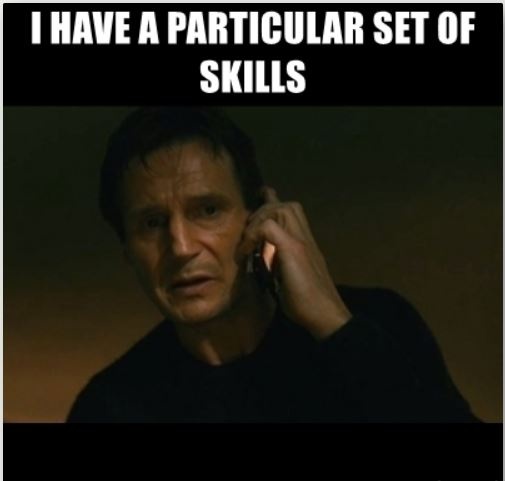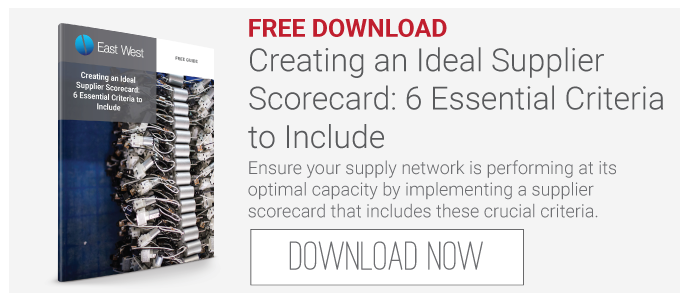I have this image of a sourcing manager talking to a supplier with the conversation going something like this, “I don’t have extruded aluminum right now, but what I do have are a very particular set of skills; skills I have acquired over a very long career. Skills that make me a nightmare for people like you. If you let me have the aluminum that you have at the price I can pay right now, that will be the end of it…”

Sourcing managers are focused on finding the best goods at the least expensive prices, and like our example, it takes a willingness to hunt down, qualify and negotiate with suppliers, and test and qualify the quality of the goods. It is a critical step in global manufacturing, one that happens early on in the product development process.
We spoke with a John Mascaritolo, director of the Center for Supply Chain Management (CSCM) at Georgia’s Clayton State University. After his successful career in the logistics and supply chain management industries, Mascaritolo moved into academia where he developed and implemented the supply chain degree program and CSCM. He had this to say about creating a global sourcing process:
“A sourcing strategy typically focuses on a category of products or services – called a category strategy. This strategy is a decision process used to identify which suppliers should provide a group of products or services, the form of the contract or Master Service Agreement (MSA), the performance measures used to measure supplier performance, and the appropriate level of prices, quality, and delivery arrangements that should be negotiated.”
Armed with that strategy, a company then devises their own way of doing business in this marketplace. The following is a proven formula for implementing a successful global sourcing process.

FIVE STEPS FOR BUILDING A GLOBAL SOURCING PROCESS
1 | BUILD A TEAM
More and more companies are taking the team approach to making sourcing decisions. Create a cross-functional team of professionals from sourcing, operations, finance and other stakeholders directly involved with the product under development. Designate a team lead. Include subject matter experts if necessary.
Action items:
Develop a scope of work and plan: The commodity team needs to create the strategy that will provide the specific details of the sourcing and outlines the actions to take in managing the sourcing strategy.
Gather data: Collect information associated with the commodity being sourced. A good database is one full year of activity. Data must be specific and detailed, i.e., annual volume of ingredients/parts or units needed for manufacturing, thorough current supplier spend, volume by location, truckload/less-than-truckload volume, etc.
2 | CONDUCT MARKET RESEARCH ON SUPPLIERS
The point of performing market research is to assess market conditions and the ability of current or potential suppliers to deliver product under those conditions. Mascaritolo calls supplier market intelligence one of the “most important and critical stepping stones for an effective category strategy.”
Action items:
Obtain research from multiple sources. Compare and contrast information from multiple, credible sources before validating your data.
Examples of credible sources include:
- Industry trade journals
- Annual corporate financial reports
- Trade consultants
- Industry/trade associations and conferences
- Your network for industry professionals
3 | STRATEGIC DEVELOPMENT
Now that you have a grasp of your data — forecasted spend; supplier market research; business activity; user requirements — it’s time to create a Supplier Evaluation Scorecard.
Action items:
Establish the scorecard criteria. The items should be on a weighted point scale based on the criterial most important to least important. The weighted factors are percentage points on a 100-point base.
Items should include:
- Management capability
- Financial health/strength and cost structure
- Manufacturing capacity
- Technological capacity
- Regulatory compliance
- Quality
4 | COMPETITIVE BIDDING PROCESS, NEGOTIATION AND CONTRACTS
It’s time to implement your strategy by putting the project out to bid. There are three different types of bids that can occur, a Request for Information (RFI), a Request for Pricing (RFP) and a Request for Quote (RFQ).
Request for Information - An RFI includes questions directed towards the supplier’s ability to handle your business activity. The information you receive from respondents will help you narrow the field and will create your ‘short list.’ You’ll then have face-to-face meetings and site visits with the suppliers on the short list.
Request for Pricing - An RFP includes your volume and spend data requesting pricing based on the sourcing strategy needs. The RFP process sets up the final selection process once all the RFPs have been returned and the results have been input into the scorecard. The final supplier selection becomes the Preferred Supplier List.
Request for Quote - An RFQ is similar to an RFP except it is typically used for price quotes for one off supplier service or for a purchase from a supplier who is not on the Preferred Supplier List. Prices quoted in RFQs will have a time limit on the price.
Negotiation: Only enter into negotiations with suppliers when you are confident that the supplier is capable of performing the requirements of the RFP as laid out in the selection process. Face-to-face negotiation is always preferred.
Contracts: This is a job for professionals. Let the company’s legal team handle the contract. However, the sourcing team lead should act as the go-between for both companies in relaying any changes or corrections, or for answering any questions about the contract.
According to Mascaritolo, contracts can take between three to six months to finalize. Selected suppliers are locked in via Memo of Understanding (MOU) which lists the full scope of the services provided by the supplier, as well as the expectations of both parties. The MOU isn’t a lengthy document, just a clear statement of who does what.
5| SUPPLIER RELATIONSHIP MANAGEMENT
It’s important that someone at the company is assigned to manage the relationship between your company and the supplier. Whether that is someone in sales, quality or operations, the ongoing relationship needs to be monitored and nurtured. Additionally, the supplier must be re-qualified on a regular basis, dependent on the status of the product or material (critical or non-critical). Below are our company's definitions of critical and non-critical material. Your company may use slightly different parameters.
Critical material - component or material failure endangers safety or survivability of personnel, or has (1) high complexity, (2) tight specifications, (3) is a medical device, (4) has other business considerations. Visit every year or every two years based on criteria.
Non-critical material - all others. Visit every three or five years based on criteria.
Your Supplier Evaluation Scorecard is the most important tool for monitoring supplier performance. Your scorecard will include categories for:
- PRICE
- QUALITY
- DELIVERY RELIABILITY
But other categories may be added as needed (see point #3 above). These scorecards are for your use, but also for the supplier to track areas that require remediation.
![]()
TOTAL COST OF OWNERSHIP AND SOURCING
We recommend looking at sourcing through the lens of total cost of ownership or TCO. This means looking at obvious costs and hidden costs. Obvious costs usually don't require too much thought — labor, materials, shipping. Hidden costs are less glaring but just as real — items like the cost of waste or downtime, the cost of turnover.
Total cost of ownership takes all costs into account, obvious and hidden. It is the actual cost it takes to make a product — not the price of a product which is a negotiated, fixed amount.
Let’s consider two scenarios. In the first scenario, you’re on your own — making a product, let’s say with a manufacturer in Vietnam. You’re doing everything yourself. You’re...
- qualifying suppliers,
- finding designers,
- hiring engineers,
- finding the manufacturers,
- writing your quality plan,
- hiring quality inspectors,
- hiring a third-party logistics firm to handle the shipping for you,
- renting a warehouse,
- hiring a warehouse manager,
- paying for labor,
- paying for insurance,
- hiring lawyers…
- You might be going back and doing some of those things again because they fell through the first time and you have to do it again. Or again.
There are probably a lot of other steps I’ve left out, but you get the idea. All those items are bought and paid for by you. When you add in the cost of all those things to the cost of your product, you have the actual price or the total cost of ownership.
In the second scenario you use a global manufacturing and distribution services partner to make your product. Again, let’s say you’ve talked it over and determined that the best place to manufacture is Vietnam. This time, manufacturing services company is the one handling all the qualifying and hiring, and those fees are folded into the final cost of the product. That, too, is the TCO. Below are some of TCO criteria you should think about when you're working with suppliers and contract manufacturers. The answers to these questions can make a measurable, monetary difference in your bank account.
TCO FACTORS TO CONSIDER
ASSISTANCE | Can the contract manufacturer you’re thinking of working with provide early stage Design or Engineering Support? Getting experienced design for manufacturing support early in your product development process can save time and money — a lot of time and money.
QUALITY | What about their reputation for quality? Your manufacturing partner should be able to share reports that demonstrate proven quality performance.
SUPPLY CHAIN | Can the global manufacturing and distribution services company you’re considering handle the shipping, distribution and logistics for your product or will you have to hire a separate third-party logistics shipper?
SATISFACTION | It’s one thing to do something right one time, but a manufacturer needs to do it right over and over and over and over and… you get the picture. Not only must a manufacturer make a product right, they must get it to you in good condition.
RESILIENCE | Stuff happens. Things go wrong. Orders get messed up. On a larger scale economies falter, volcanoes erupt, winds and politics shift. Your manufacturer needs to be agile and responsive to the large and small disruptions that can affect business. Using multiple suppliers in multiple locations is a wise business practice.

CHARACTERISTICS OF A GOOD SUPPLIER RELATIONSHIP
Once you've found a supplier, it's essential to build and maintain a strong, healthy relationship. We believe there are four essential characteristics of any good relationship between customer and supplier.
1. Capability
The supplier has to be able to do what you need them to do. Can they make your product out of the material you need. But the next step is also crucial. Can they grow with you?
- Do they have multiple manufacturing capabilities?
- Can they scale up? Do they want to?
2. Communication
Responsiveness is an important attribute in any relationship. You want to be able to get in touch with your supplier when you need them, and you want them to communicate with you as well. If your supplier is overseas, this is even more important. Make sure to have a native speaker who can translate for you on your calls. We also recommend you read our blog post about How to Overcome Language Barriers When Manufacturing Overseas.
- How frequently will they report to you?
- Will they call or email?
- Who will be your point of contact?
- Will you receive written reports? How regularly?
3. Transparency
Open, honest communication and operations is what customers are looking for. Customers want to see where their products are being made. They want a supplier that welcomes them to the factory floor.
- When can I visit the facility?
- How much notice do you need?
- Can I get a list of references and other customers?
- Who are some of your suppliers?
4. Quality
Obviously, products are useless if they don't perform to standard. Customers are looking for suppliers who can meet the basic industry performance standards, and in many cases, outperform those standards. They are looking for a supplier who makes a part right the first time, and every time after that.
- What is your Quality Plan?
- What third-party testing and certifications capabilities do you have at your facility?
Your company's success will be built on a good sourcing strategy and creating a sound sourcing process. By measuring the performance of your suppliers, and aligning their capabilities with your needs, both your businesses will be set up to excel and flourish. And that's the best kind of partnership.




.jpg?width=176&height=56&name=MR_associatedNetwork_logo%20(1).jpg)